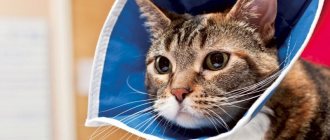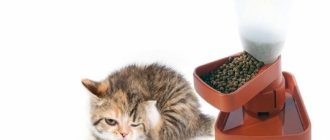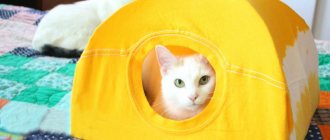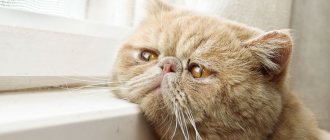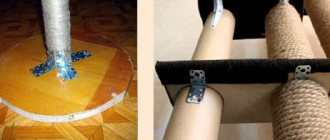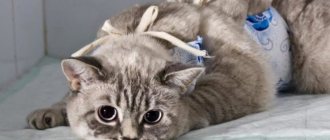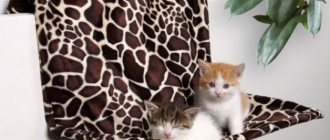It’s rare that an animal pleases its owners with absolute health and never gets sick. And no matter how much you would like to visit a veterinary clinic solely to vaccinate your pet, sometimes they require surgical intervention.
The most common operation now is sterilization and castration of cats. Uncastrated cats, especially those who were given hormonal drugs, suffer from mastitis, cystosis, purulent pyometra (purulent inflammation of the uterus), hydrometra (fluid formation in the body of the uterus), mammary cancer, tumor diseases of the uterus and ovaries. All these conditions threaten the cat's life and require immediate surgical intervention. Operations are also performed for fractures, ruptures of internal organs and for other reasons.
The main question after the owners have taken the animal from the veterinary clinic is how to care for it now? In addition to injections, tablets and ointments for treating stitches, the cat needs a protective collar.
What is a safety collar?
A protective or Elizabethan collar for cats is a means of barrier therapy, a veterinary device that limits the animal’s mobility and prevents it from damaging the integrity of post-operative sutures by gnawing, licking or scratching. It also prevents you from licking external preparations from the body or scratching damaged areas (bite marks, burns).
A properly selected protective collar for cats fits comfortably on the animal, does not interfere with its movement, eating and drinking, while limiting access to wounds, stitches on the body and limbs.
The only discomfort with a well-chosen and put on collar is the inability to lick yourself. Cats are clean animals and may be concerned about leaving scent marks. But this inconvenience is nothing compared to broken stitches, drug poisoning and damage to healing wounds. So the animal will have to be patient.
What to replace it with?
It is not difficult to make a pattern for such a product.
You can make a collar for a cat after castration yourself from scrap materials. Transparent, loose plastic, cardboard, or fabric are suitable for this. The pattern of a cone-shaped collar is not difficult to make. Initially, a semicircle is cut out, the diameter of which is 20-25 cm. Then the part is rolled into a funnel and a hole is cut out at the base, equal to the circumference of the cat’s neck. The sides are stapled or framed with ribbons.
To avoid injuring the cat, the edges of a product made of plastic or cardboard should be covered with tape or adhesive tape. A quick solution to the problem is to use disposable tableware. The plate must be cut in one place towards the center. Then cut a circle in the middle corresponding to the diameter of the pet’s neck. This slit will help you easily put on the resulting collar. Secure the incision with tape or a stapler. It is acceptable to use both plastic and paper disposable plates. But it is worth remembering that protective collars made of paper are short-lived. The edges of the vessel are also treated with adhesive tape.
Why does a cat need a collar after surgery?
A cat collar is needed in the following cases:
- When the animal has undergone surgery, especially abdominal surgery. For good healing, the sutures must be dry and intact, but a cat with a wet and rough tongue or sharp claws can damage them. Nature does not provide for such a complication as surgery, so the cat instinctively strives to lick the sore spot, “scratch” the veterinary drug applied to the suture, especially if it has an odor.
- When the cat underwent castration. Although he does not need stitches, he may also damage the incision site, lick off the antiseptic powder, and cause bleeding at the surgical site.
- When your cat's ears hurt. She will try to scratch them with her paws or on objects. In this case, the ears will be constantly inflamed, swollen, and the applied drugs will be mechanically removed.
- When the cat’s body is treated with drugs for external use: against ecto- and endoparasites, antifungal or antiseptic. Licking them from the skin and fur, firstly, will negate the healing effect, and secondly, can lead to poisoning. In kittens and small animals, intoxication develops so quickly that it is not always possible to deliver the animal to a veterinary clinic.
Postoperative period
After castration, which is carried out under anesthesia, in about 20-30 minutes you can take the cat home from the veterinary clinic. It is best to place the operated cat on a soft, clean bedding on the floor, since coordination of movements is impaired for several hours after anesthesia. In addition, the cat is very weak and may experience severe discomfort. Some pets show anxiety and cannot find a place for themselves, while others, on the contrary, recover from anesthesia and constantly sleep.
This condition can last from 24 to 48 hours. It all depends on the weight, age of the cat, general condition, individual parameters, the state of the nervous system, as well as on the dose of anesthesia used for anesthesia of the drug.
Caring for a neutered cat involves creating the most favorable, calm environment possible. During this period, the pet needs increased attention and care, since any surgical procedures are stressful for the cat.
Despite the fact that postoperative wounds are small and heal quite quickly, in order to avoid possible complications, it is necessary to closely monitor your pet.
Your veterinarian will tell you how to properly care for your cat after surgery, what to use to treat wounds, and when you need to bring the cat to have stitches removed, unless, of course, you used self-absorbable surgical material.
To ensure that the rehabilitation period passes quickly and without any complications, follow all the recommendations of the veterinary surgeon.
In the first two or three days, make sure that the cat does not rub its back on the floor or try to remove the stitches. But since it is not always possible to monitor the cat around the clock, we recommend wearing a special protective collar. Only take it off when feeding.
What to choose: a collar or a postoperative blanket?
Cats after abdominal surgery are sometimes put on fabric blankets.
The big advantage of the blanket is that it protects the seam not only from the impact of the cat itself, but also from contact with objects. At the same time, the cat’s movements are not limited, she almost does not feel the blanket and quickly gets used to it. The pet can lick itself and not worry about the smell.
The disadvantages of a blanket are that it gets dirty quickly, and your pet can tear it off with its claws. The movement of the tongue along the blanket at the seam site sometimes leads to damage to the seam, even through the fabric. The blanket cannot be used when treating the animal's body, because it will absorb ointments, sprays and gels.
The advantage of the collar is that access to the site of surgery or treatment is completely limited. The collar will prevent the cat from hiding in a hard-to-reach place where they often hide when they feel unwell.
The disadvantages of the collar are as follows:
- it is less comfortable for a cat to wear than a blanket;
- it can cling to objects;
- It’s also more difficult to pick up than a blanket.
Making a postoperative cap with your own hands
You can choose a collar to suit every taste, but if it is needed urgently, and the owner cannot immediately purchase the device, it is made with his own hands.
Regardless of the material chosen, the main thing in its manufacture is convenience and safety for the pet, so you need to carefully follow the instructions and correctly take measurements from the cat. How to make a collar at home?
Rigid plastic bottle design
This is the most practical product that can be used throughout the entire treatment period. To make a collar from a plastic bottle, you need:
Soft stopper made of thick fabric or foam rubber
It is recommended to sew soft collars from natural fabrics so as not to provoke an allergic reaction in your pet. Instructions for sewing a soft collar:
How to put a post-op collar on a cat?
You can choose a cat collar in our veterinary pharmacy!
There are two types of collars:
- The first option is cheaper. This is a semicircle that wraps around the cat’s neck and is fastened with “tabs” inserted into the slots. If the cat does not agree to wear a collar, then one person will have to hold it, and another person will fasten the collar.
- The second option is more expensive, but more convenient. It is attached to a decorative or anti-flea collar: its edges are equipped with Velcro and are easy to fasten. It's easy to put on, even on a reluctant cat alone.
Important! After surgery, the cat must be handled with extreme care: do not squeeze it, do not grab it sharply and do not forcibly pull it out, holding it by the paws, from somewhere in order to avoid damage to the sutures, internal bleeding or an epileptic seizure.
Wearing rules
The cat needs the accessory after surgery; if worn correctly, it can be removed in 3-5 days.
To prevent the cat from being able to remove the collar, when choosing and purchasing a product, you need to inspect the fasteners and evaluate their reliability. When putting on the accessory, adjust it so that the headband does not tighten the neck, but is not too loose, otherwise the pet will take it off. If your cat has experience wearing a collar, it will be easier to put a neck post on him.
We can recommend purchasing a product made of hard fabric with padding - these models are more elastic than hard plastic ones, but they will prevent licking no less effectively. When wearing a protective collar, the following rules must be observed:
- do not remove the accessory while the animal is sleeping;
- do not leave the cat unattended if for some reason the stand had to be removed;
- do not try to loosen the collar if you can stick a finger between it and your neck;
- If you refuse to feed due to putting on the stand, you will have to remove the object that is bothering the cat only for the duration of feeding (according to the schedule).
It is recommended to encourage animals more often during the entire period of wearing the collar: pet them, talk affectionately, give them treats.
Pros and cons of castration
The procedure has a number of advantages that affect the physical and mental state of the pet.
Pros:
- the cat stops marking its territory, the disgusting smell disappears;
- calls for cats stop;
- the fluffy becomes calm and does not show aggression towards people and other pets;
- attempts to jump out of a window or balcony stop, and, accordingly, escapes from the house;
- fights with other cats are excluded;
- eliminates the likelihood of your pet becoming infected with a number of diseases due to frequent matings with different cats;
- the risk of developing pathologies such as prostatitis, adenoma, tumor of the paraanal glands is reduced;
- the pet lives 1.5-2 years longer.
Related article: Everything you need to know about caring for your cat after sterilization
Minuses:
- an increase in the cat’s body weight, the development of obesity and heart disease (the cause is a decrease in mobility and a slowdown in metabolism);
- against the background of urolithiasis, the risk of blockage of the urethra with stones or sand increases;
- The anesthesia required for the operation may have side effects (the result depends on the skill of the veterinarian).
To prevent the negative consequences of castration, you should feed your pet correctly, limiting portions. This will prevent obesity. It is also necessary to prevent urolithiasis, use special food and nutritional supplements. Before the operation, you should have your pet examined by contacting a trusted clinic with highly qualified staff.
When should you use an Elizabethan collar?
Such a device may be needed when not the most pleasant events happen to your cat, these could be:
- wound;
- surgical sutures;
- scratched wounds;
- castration;
- other skin damage.
For example, you need to apply ointment and a bandage to the damaged area, and to prevent the cat from licking it off, we put on a so-called Elizabethan collar. It ensures your pet a complete and safe recovery. You can buy it at any pet store or make it yourself.
Tip: use an Elizabethan collar to treat your cat against blood-sucking parasites or after bathing in insecticides. Most of these products are safe only after drying, and the collar will prevent the cat from licking himself while the fur is wet.
Types of devices
After castration, the cat must wear a protective collar.
It is important to take great responsibility when choosing a product. When choosing a device, take into account the structure and weight of the animal
The main criterion is neck circumference. The pet should feel comfortable, so the collar should not be tight or loose. The gap in the neck area is no more than two fingers. There are 3 types of collars available in pharmacies and pet stores:
- plastic;
- inflatable;
- soft.
Plastic
Plastic products are a truncated cone with ties that secure the collar. To reduce discomfort, the edges are treated with soft fabric or lacing. Fixation tapes can be replaced with Velcro. The cone-shaped shape does not interfere with the pet's eating, drinking water and sleeping. The animal gets used to this attribute in 2-3 days.
When choosing a plastic collar, you should choose a product made of a more transparent material, which will provide your pet with a good lateral view and will not interfere with free orientation in space. All this will make the cat less nervous and irritated. Such products are distinguished by their practicality, simple disinfection method and low price. However, not all cats feel comfortable with a plastic device. If your pet takes off its collar, you need to hold it in your arms for a while and treat it with something tasty. It is better to remove the collar for a short time while eating. If your pet is irritable and restless, it is recommended to purchase a different type of product.
Inflatable and soft
Devices of the first type are much more convenient for cats. They are made in the form of a roller or circle from a material that is easy to clean. Such collars do not irritate the skin, do not cause allergic reactions, and do not interfere with full vision. The only drawback is the price of the device. It greatly exceeds the cost of plastic. If we talk about soft collars, they are made of non-woven materials on a water-repellent basis and have a cone shape. It is not difficult to put the product on an animal. The pet feels quite comfortable in it. No allergies are observed when wearing it. The cost, unlike inflatable, is more affordable. For very active cats, these collars are the least practical because they can remove even tight collars and get to the sore spot.
Scrotal swelling
If there are no medical indications, then the scrotum is not removed during castration of a male dog. Immediately after surgery, this leather pouch remains empty. Doctors may briefly apply a heating pad with ice to the scrotum to cause the blood vessels to constrict.
Don't worry about the aesthetic side of the issue - in a few months the skin will magically tighten. There will be a smooth place where the testicles were.
True, this takes time. But the body does not tolerate any emptiness and strives to fill it. Therefore, lymph can accumulate in the scrotum. On the third or fourth day, it looks as if the testes have returned to their place! This is fine.
Sometimes the swelling can be too strong and painful. This happens in several cases:
- Blood clots had accumulated in the scrotum because a vessel was damaged and not ligated.
- The wound became infected and inflammation began.
- Rejection of the suture material occurs (the latter situation is extremely rare; usually the problem is a violation of sterility).
In which case should you see a veterinary surgeon as soon as possible:
- the scrotum is purple or bluish in color;
- the swelling is so strong that the scrotum is larger in size than before the operation, the skin is stretched;
- discomfort when walking in a dog, signs of pain.
We invite you to find out how many years do huskies live at home?
The doctor may prescribe novocaine blockades with an antibiotic or systemic antibiotics; sometimes surgical revision of the wound is required (under local anesthesia).
You can see more photos of Labski HERE (link will open in a new tab)
